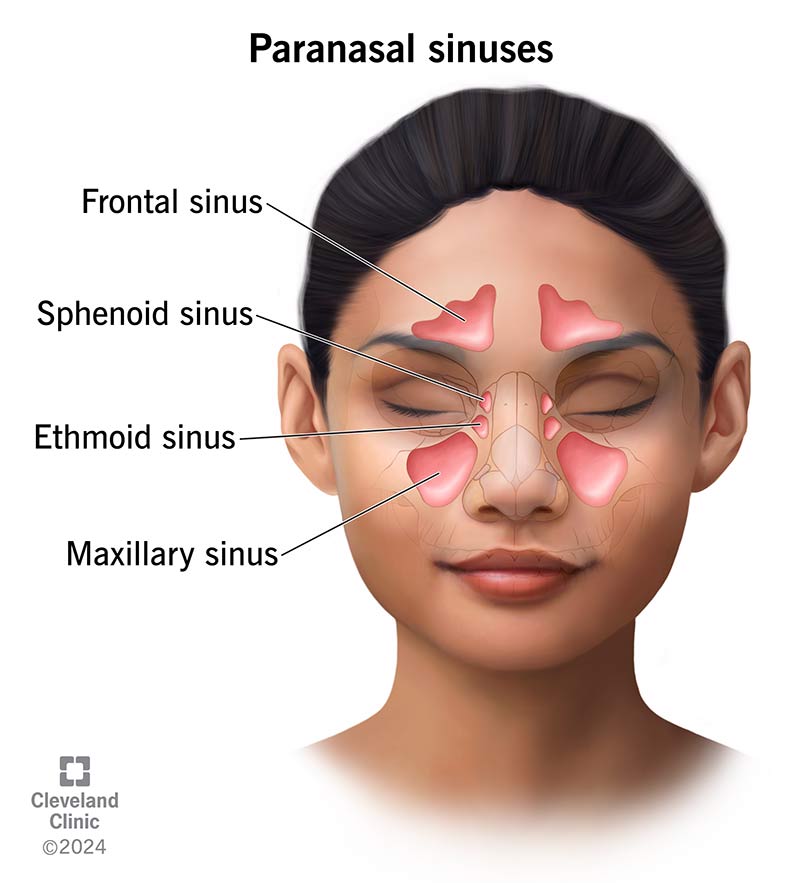Your paranasal sinuses (or just your “sinuses,” as most people call them) are four paired cavities in your face. They include the frontal, sphenoid, ethmoid and maxillary sinuses. Together, they make mucus that drains your nose, keeping it free of germs and allergens. The most common condition that affects them is called sinusitis.
Advertisement
Cleveland Clinic is a non-profit academic medical center. Advertising on our site helps support our mission. We do not endorse non-Cleveland Clinic products or services. Policy

Your paranasal sinuses are four paired, air-filled spaces (cavities) inside the bones in your face. Most of us know them as just our “sinuses.” Technically speaking, “sinus” is a broad medical term that may refer to different air-filled cavities inside a bone or another type of tissue, like a blood vessel. For example, there are sinuses in your brain and heart.
Advertisement
Cleveland Clinic is a non-profit academic medical center. Advertising on our site helps support our mission. We do not endorse non-Cleveland Clinic products or services. Policy
But when most of us think about our sinuses, we mean the paranasal sinuses — the ones near (“para”) the nose (“nasal”). You likely don’t notice them until you have a cold, infection or allergies that are “acting up” and causing pressure in your face or a stuffy nose. Then, they’re impossible to ignore.
Your paranasal sinuses are more than a source of irritation when you’re sick. Although experts are still learning about all they do, some jobs your paranasal sinuses help with include:
Advertisement
There are four paranasal sinus cavities. They’re paired, so you have one on the left side of your face and one on the right side. Each is named after the facial bone where it’s located. Together, they form a mucus drainage system that empties into your nasal cavity, the air-filled space behind your nose.
From top to bottom, your paranasal sinuses include:
Your sinuses drain into multiple passages that lead to your nasal cavity. A key one to know about is the ostiomeatal complex. It’s a pathway that includes many parts. It drains your frontal, ethmoid and maxillary sinuses. Blockages in this area make you particularly susceptible to inflammation (swelling) and infection.
Most sinus conditions are related to inflammation in your sinuses, allergies or an infection. Abnormal growths sometimes form in the paranasal sinuses. They’re usually benign (noncancerous), but they can be precancerous or cancerous, as well.
Common conditions include:
Advertisement
Signs and symptoms of simple, uncomplicated sinus conditions include (but are not limited to):
The aches, pains and pressure often correspond with where the inflammation is in your sinuses:
Healthcare providers can usually diagnose common causes or paranasal sinus issues with a physical exam and by considering your signs and symptoms. In some cases, your provider may perform an imaging procedure.
Nasal endoscopy may be an option if your provider needs to take a closer look at your sinuses or nasal passages and potentially take a sinus culture. For this test, your provider inserts a thin, flexible tube with a camera on the end into your nose. It records video of your sinuses that your provider can see on screen.
Often, symptoms of common conditions, like sinusitis, are mild and go away on their own. But you may need medicines, like pain relievers to help with symptoms. Your provider can prescribe medications, like antibiotics, for bacterial infections.
Advertisement
Common treatments that can help manage symptoms include:
You may need sinus surgery for several reasons, including:
Avoiding viral infections (which can lead to bacterial infections) and managing your allergies is key. You can:
Most of us don’t give our sinuses a second thought — until we’re sick and experiencing symptoms of a head cold or an infection that won’t let up. But your sinuses aren’t just sites of irritation. They’re immune system helpers that drain germs from your body. You can protect them by steering clear of allergens that may irritate them. Keep them free of infection by taking steps to keep from getting sick.
Advertisement
If you have conditions affecting your ears, nose and throat, you want experts you can trust. Cleveland Clinic’s otolaryngology specialists can help.

Last reviewed on 08/03/2024.
Learn more about the Health Library and our editorial process.